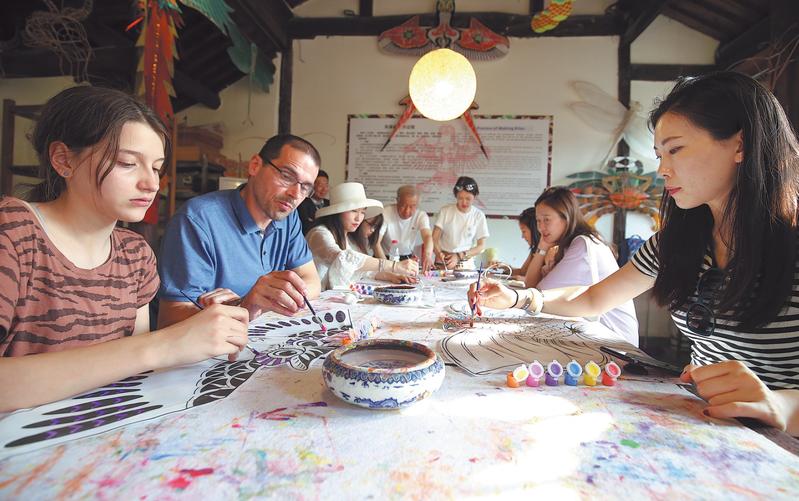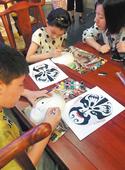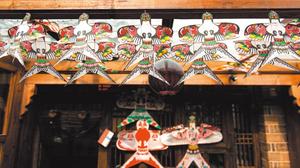Beijing authorities have accredited 16 attractions in the city as destinations with outstanding folk appeal, Yang Feiyue reports.
 Tourists learn kite-making while visiting Beijing Wtown in the capital's Miyun district. (PHOTO PROVIDED TO CHINA DAILY)
Tourists learn kite-making while visiting Beijing Wtown in the capital's Miyun district. (PHOTO PROVIDED TO CHINA DAILY)
The Beijing Municipal Bureau of Culture and Tourism designated 16 destinations in the capital as cultural-tourism models in late December.
They were selected according to their vitality, innovation and market influence. The move is intended to integrate Beijing's cultural resources with tourism demand, and offer diverse and customized travel experiences.
A total of 100 such models in the capital will be accredited in the future, according to the bureau.
The first 16 reflect Beijing's ancient and modern development, culture and customs.
Beijing Enamel Factory, Dongcheng district
Professional enamel artists guide visitors through the factory's workshops to fully experience the medium at the country's first cloisonne museum. A tour of the factory helps visitors to better understand the historical context, geographical influences and techniques behind cloisonne. Visitors can also make their own cloisonne under professional guidance.
Beijing Fenglei Peking Opera Co, Xicheng district
Peking Opera professionals walk tourists through the history of the genre and the troupe, and help them understand such dimensions of the opera as musical instruments. Classic repertoires are performed. In the last session, visitors are invited onstage to interact with actors and learn certain movements and opera singing. They can also put on Peking Opera costumes and makeup.
Yongning town, Yanqing district
Travelers can join guided tours of the town founded in the Tang Dynasty (618-907). They can learn about its rich farming and nomadic culture and history, and food and customs, while taking in the architecture featuring elements from the Ming (1368-1644) and Qing (1644-1911) dynasties. The resort has signed agreements with 40 folk artists who practice over 20 art forms, including ceramics, pyrography, straw braiding, leather carving and paper-cutting. Visitors can learn about local intangible heritage's history and techniques, and make folk items under artisans' guidance.
 Children practice painting Peking Opera figures at Fenglei Peking Opera Co. (PHOTO PROVIDED TO CHINA DAILY)
Children practice painting Peking Opera figures at Fenglei Peking Opera Co. (PHOTO PROVIDED TO CHINA DAILY)
Beijing Wtown, Miyun district
The water town stands in the shadow of the Simatai Great Wall and boasts picturesque mountain and water views, and traditional-style quadrangular courtyards built on mountain slopes. One can enjoy folk-custom experiences at Beijing Wtown, including stilt walking, dragon dances and folk acrobatics. The town offers old-fashioned liquor brewing, tie-dyeing, Chinese shadow puppetry, and kite-and lantern-making experiences. It also hosts standup comedy, Peking Opera and drone light shows.
Han Meilin Museum, Tongzhou district
The Han Meilin Museum sits by the Grand Canal and displays a wide range of media, including paintings, calligraphy, sculptures and handicrafts. The museum is equipped with professional Chinese, English, French, Japanese and Korean guides to help visitors comprehensively understand each work and its cultural background. Modern technology offers complementary visual experiences, such as a 3D virtual-exhibition hall, smart-voice guides and large touchscreen displays. Art creation, art fairs and artist lectures offer immersive experiences.
Beijing Erguotou Intangible Cultural Park
The park comprises two liquor museums respectively located in Huairou and Xicheng districts. Travelers can experience the charm of Erguotou-a strong, clear sorghum-liquor variety-using all five senses. Guides explain the relevant culture, from traditional brewing to tasting skills. Visitors can also tour the digitized smart-production workshops and storage systems. And they can get their photo printed as a bottle label.
Jingren's Paperlogue, Dongcheng district
The paper-culture park offers various paper-handicraft-making experiences, including programs for leisure, team building, families and school internships. Professionals will guide visitors to make books, toys and daily necessities by answering questions and imparting paper-art skills. Visitors can learn about thousands of colorful paper materials created for specific purposes from around the world and get paper products customized to their tastes. The park also hosts paper-art exhibitions and exchanges.
Liangshan Enamel Plant, Shunyi district
The 7,500-square-meter plant was built in 1966 and offers a comprehensive review of cloisonne's history and development. Master artisans present elaborate explanations of the tools and techniques, including filigree, glazing and compacting. Its art-experience zone can accommodate 100 visitors.
 Ceramic artworks are on display at Beijing Ceramic Art Museum. (PHOTO PROVIDED TO CHINA DAILY)
Ceramic artworks are on display at Beijing Ceramic Art Museum. (PHOTO PROVIDED TO CHINA DAILY)
Malan village, Mentougou district
The village is about 60 kilometers from downtown and used to be home to a major Communist Party of China force against the Japanese who occupied Beijing in 1937. The village receives about 100,000 visitors a year. Travelers can relive local history through guided tours and visit historical sites, including the former site of a Chinese army commander's headquarters. Related art performances are staged, and military songs are taught.
Beijing Folklore Museum, Chaoyang district
The museum is located inside the Taoist Dongyue Temple built during the Yuan Dynasty (1271-1368). It hosts a traditional-Chinese wooden-structure exhibition explaining construction methods that have been passed down for more than a millennium. Professional ancient-architecture repair and design experts explain to visitors Dongyue Temple's features, paintings and history. Visitors can interact with ancient-architecture specialists to better understand the traditional culture behind the temple. Patrons can also take painting classes of various levels.
Beijing Ceramic Art Museum, Chaoyang district
The museum area shows the history of ceramics using replicas of ancient porcelain pieces, miniature landscapes and new-media images. Visitors can see how ceramics are used in daily life, medicine, aviation and automobiles. Ceramic artworks are also on display. Visitors can make and paint ceramics with professional instructors. The museum also regularly holds tea ceremonies, and ikebana and calligraphy programs.
Beijing Tongrentang Health Management Facility, Daxing district
The facility integrates traditional Eastern culture and modern philosophy. It offers food-based therapies for the 24 solar terms throughout the four seasons. Visitors can get insights into the medical effects of herbal teas, baked goods made with herbs, and coffee infused with wolfberries, monkfruit and licorice. Visitors can get traditional Chinese medical testing and treatment.
 An exhibition of kites at traditional-style quadrangular courtyards in Wtown. (PHOTO PROVIDED TO CHINA DAILY)
An exhibition of kites at traditional-style quadrangular courtyards in Wtown. (PHOTO PROVIDED TO CHINA DAILY)
Wenwangge Museum of Wooden Crafts, Tongzhou district
The museum displays restored historical wooden items with explanations about the culture behind their creation. Visitors can learn about ancient China's carpentry, agriculture, military, weights and measures, weddings and the Grand Canal. They can also try assembling mortise-and-tenon structures, and dismantling small stools and Lu Ban locks. Or they can build unpowered cars, make rubbings of the Chinese zodiac animals, produce ancient-style furniture and create paintings using woodchips and shavings.
Yishengyuan Korean Food and Folk Culture Base, Daxing district
Yishengyuan offers suburban experiences while showcasing traditional Korean culture and customs. It's popular among families and people who drive. It also provides student internships. Travelers can tour the food-processing line with professional guides to understand the history and culture of Korean foods, such as pickles. They can also make and taste certain delicacies.
Beijing Century Yili Industry Tourism Base, Daxing district
The attraction explores the long history of the time-honored brand, Century Yili. Visitors can walk over the old equipment, and the modern bread-and soda-production lines. Guides offer explanations of the technical processes and answer questions. Visitors can bake bread or cakes from scratch under the instruction of master bakers. About 100,000 people visit every year.
China National Film Museum, Chaoyang district
The 38,000-square-meter museum narrates the history of film's development and film production, reel by reel. Visitors can experience rural courtyards, screen syntheses, digital-stunt blue-screen matting, immersive 3D animation and VR "space capsules". They can get the big picture of China's big screen, from shooting to editing, from dubbing to music. The venue also hosts six cinemas. It has received over 4.5 million visits since it opened in 2007.
Contact the writer at yangfeiyue@chinadaily.com.cn


